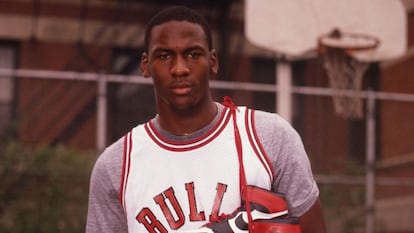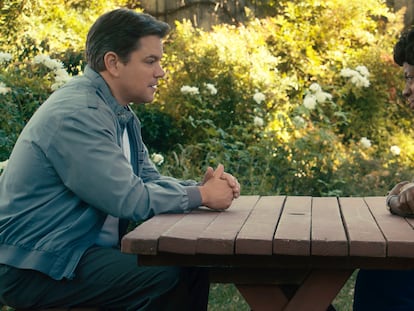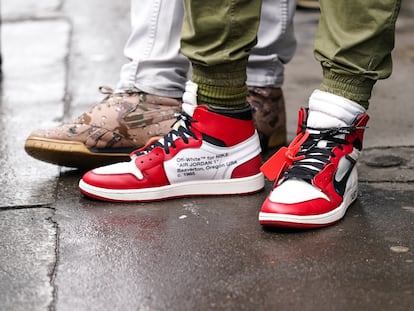The day Michael Jordan’s mother changed Nike’s history forever: ‘Even if you don’t like it, you’re going to listen to them’
Directed by Ben Affleck, the new film ‘Air’ tells the story of the brand’s efforts to sign the promising young basketball player, giving rise to a partnership that altered the course of sportswear and produced a multibillion-dollar industry
In 1984, Nike was at a low point. Founded in 1964 by athletic trainer Bill Bowerman and one of his students, Phil Knight, in the 1980s the company was failing to increase its sales and its image was that of a technical apparel brand that lacked a presence beyond sporting arenas. Meanwhile, Nike’s competitors had moved ahead of it by adapting to the times. Adidas was setting trends in the emerging urban fashion scene, as rap group Run-D.M.C.’s hit song “My Adidas” soon demonstrated. For its part, Converse dominated the shoe business within the NBA, and two of the league’s biggest stars, Magic Johnson and Larry Bird, were the faces of the brand. Nike needed something bold to shake itself out of the doldrums and a face that would give it a recognizable personality. The company found its solution in a 21-year-old basketball star who had yet to play a single professional game.
Thus begins Air, the latest film directed by Ben Affleck. The movie tells the story of Nike’s negotiations to form a partnership with Michael Jordan, a collaboration that nearly 40 years later remains one of the most lucrative in sports apparel. Last year, the Air Jordan brand brought in $5 billion (about €4.6 billion at current exchange rates), 11.5% of Nike’s annual earnings, while Michael Jordan regularly appears on lists of the highest paid athletes each year, despite having retired in 2003. A recent study by the Sportico website, which specializes in sports business, ranks him as the highest-income athlete in history; he’s worth $3 billion (more than €2.671 billion). But that historic alliance almost didn’t happen, and Michael Jordan’s mother played a key role in ensuring that it did.
The history of a courtship
In the documentary The Last Dance, when asked which brand he wanted to sign his first shoe deal with as a professional athlete, Michael Jordan bluntly answers “Adidas.” In 1984, Jordan made the leap from the University of North Carolina to the NBA. At that time, the player and his agent, David Falk, began to hear proposals from sports companies. Jordan was so sure of his potential that he demanded that his suitors give him his own exclusive model of sneakers; back then, few players had that privilege. As Falk says in the documentary, Adidas was not in a position to meet that demand. Converse, the NBA’s official shoe brand at the time, already had other stars on its payroll and did not seem to want to give preferential treatment to a rookie who had not yet stepped on an NBA court. These circumstances created an opening for Nike to take advantage of.
“Jordan was clear on the fact that he didn’t want to [sign a shoe deal] with Nike,” Sonny Vaccaro, the executive who led the company’s negotiations with the player, explained in a recent interview. (In Air, Matt Damon plays him.) Vaccaro had discovered Jordan in the 1982 college basketball championship in which Jordan scored a decisive basket. Another legendary player, James Worthy, was the MVP of that game but Vaccaro was more intrigued by the charisma and aesthetic moves of the kid who stuck his tongue out as he shot the ball. “We wanted to convince him that this still-young company was capable of doing something that had never been done before,” Vaccaro says. But to do that, Jordan first had to take the brand seriously.
Nike’s first interactions with Jordan were certainly not encouraging. “Jordan didn’t even know what Nike was,” recalls the executive, who managed to meet with him during the 1984 Los Angeles Olympics. But Vaccaro was insistent and trusted his vision. Nike had a $2 million budget to sign several young players, but Vaccaro convinced the brand to go all in on Jordan. The company hoped that making a much bigger offer than Adidas and Converse would convince the future star to agree to a meeting at Nike’s offices.
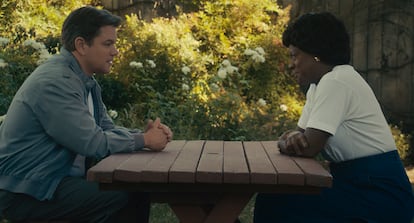
The day before he was to meet with Nike’s top brass, Michael Jordan decided he didn’t want to go. He didn’t feel like taking a flight to talk about a deal he didn’t believe in. Then Deloris Jordan, his mother, intervened and changed the course of both her son and Nike. “She told me, ‘You’re going to go listen to them. Even if you don’t like it, you’re going to go listen to them,’” Michael Jordan himself recalls in The Last Dance. “After the first meeting, it was clear to me that the way to reach him was through his family. Michael only listened to his family, especially his mother,” Vaccaro says.
So, at his mother’s urging, Michael Jordan arrived at Nike’s offices in Oregon. There was a special banner for the occasion that read, “The Nike family welcomes the Jordan family.” All accounts of the meeting describe Jordan as uninterested, but the proposal won over his family. The final detail was the 5% of annual sales that Nike offered the player, which would make Jordan the highest paid athlete of all time. “After the meeting, my father told me I’d have to be crazy not to accept [it]. It was the best deal,” Jordan recalls. The decision still took a few months, but by the fall of that year, just before he made his NBA debut, the partnership was a done deal.
An icon’s shoes
In his first game with the Chicago Bulls, Michael Jordan wore red and white sneakers that were sold at auction years later for $1.47 million. The Air Jordan I shoes designed specifically for him were not ready until later that year; they went on sale in 1985. By that time, No. 23 was already the most promising young player in the league and his charisma was beginning to conquer the public. “Nike’s projections were for $3 million in sales in the first year, but during that time they made $126 million,” the player’s former agent, David Falk, explains.
Air Jordans went on to become legendary sneakers, particularly the red and black ones. The myth that has grown around it says that the player was fined $5,000 every time he wore them in a game for violating NBA dress code rules, though that has never been confirmed. The success of Jordan’s sneakers marked the beginning of a strategy that Nike maintains to this day: it comes out with a new Air Jordan sneaker almost every year. However, in 1988, the Bulls shooting guard, who was insatiable both on and off the court, threatened that he would not renew his contract with the company and leave it for Adidas. At that point, Tinker Hatfield, Nike’s other savior and the man responsible for globalizing Air Jordan fever, arrived on the scene.
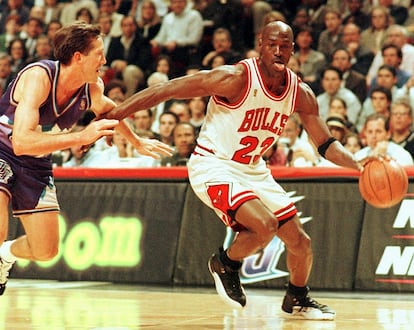
“I wasn’t aware of the gravity of the situation and how important Michael Jordan was to Nike,” Hatfield recounted in the documentary Abstract: The Art of Design. He started working at the company in 1981 and was one of its most innovative designers. Hatfield had created another legendary shoe, the Air Max I, and was commissioned to design the Air Jordan III, the sneaker that had to persuade MJ not to leave the company. “We had a meeting with him to present [the sneakers] …and it took Michael four hours to show up. He was playing golf with other people, who were [telling] him to switch [companies],” Hatfield recounts. “He finally showed up in a bad mood and said, ‘What do you have?’” The innovations in design and materials piqued his interest, but Hatfield had held back one last element: the model came with a whole line of sportswear. “It was like the exclamation point at the end of a sentence.”
From then on, the pairing between Nike and Jordan became a trio; behind the scenes, Hatfield was the driving force. “Jordan had the ability to command the attention of people beyond the sports world, and Tinker found a way to translate that character and turn it into sneakers,” explains DJ and sneaker collector Bobbito Garcia in the aforementioned documentary. “The brand became huge with Air Jordans III, IV and V.” Jordan noted that he “wanted basketball shoes that you could wear to a game and [then] wear with a tuxedo that same day.” The idea worked to perfection: the rise of urban fashion cannot be understood without discussing Air Jordan and the brand’s ability to turn sporting goods into items that can easily be worn everywhere.
Creating a new model
“Jordan opened the door to a multibillion-dollar industry for athletes,” Vaccaro explained recently. Indeed, while he was not the first athlete to serve as the face of a brand, he created a new model. On the one hand, sportswear transcended the sports for which it was designed and became a fundamental part of urban fashion. On the other hand, the Jordan-Nike partnership activated a machine that constantly created sneakers and clothing revolving around different sports figures. This industry has grown to such an extent that, in some cases, shoe deals have earned athletes more money than the salaries they receive for playing their sport. For example, before entering the NBA, Zion Williamson signed a deal with Air Jordan that brings in more income annually than his salary as a player for the New Orleans Pelicans.
Today, all NBA stars have their own sneaker lines, and new models come out almost every year. A player’s retirement (or even death, as in the case of the late Kobe Bryant) does not stop the juggernaut from continuing to churn out new products for sneaker fans, an entire subculture that began with the rise of Air Jordans. Surprisingly, that entire process was set in motion by a mother’s scolding. For that reason, Deloris Jordan—played by Viola Davis at the request of Michael Jordan himself—figures prominently in Air. Ben Affleck explained in an interview with The Hollywood Reporter that he asked Jordan for “anecdotes” about his father. “Without going into any more detail, he actually talked about his mom, who wasn’t really in the script,” Affleck recounted. “That’s when I understood what the movie was. Talking to him about his mom was incredibly moving, and I realized, ‘Oh, this isn’t about Nike.’”
Sign up for our weekly newsletter to get more English-language news coverage from EL PAÍS USA Edition
Tu suscripción se está usando en otro dispositivo
¿Quieres añadir otro usuario a tu suscripción?
Si continúas leyendo en este dispositivo, no se podrá leer en el otro.
FlechaTu suscripción se está usando en otro dispositivo y solo puedes acceder a EL PAÍS desde un dispositivo a la vez.
Si quieres compartir tu cuenta, cambia tu suscripción a la modalidad Premium, así podrás añadir otro usuario. Cada uno accederá con su propia cuenta de email, lo que os permitirá personalizar vuestra experiencia en EL PAÍS.
¿Tienes una suscripción de empresa? Accede aquí para contratar más cuentas.
En el caso de no saber quién está usando tu cuenta, te recomendamos cambiar tu contraseña aquí.
Si decides continuar compartiendo tu cuenta, este mensaje se mostrará en tu dispositivo y en el de la otra persona que está usando tu cuenta de forma indefinida, afectando a tu experiencia de lectura. Puedes consultar aquí los términos y condiciones de la suscripción digital.
More information
Archived In
Últimas noticias
James Cameron: ‘For the films I like to make to continue to exist, we have to find a way to make them cheaper’
Families demand repatriation of bodies of Colombians who died in Ukraine: ‘This war is a slaughterhouse for foreigners’
Mexico’s missing people crisis casts a shadow over World Cup venue
ICE raids trigger school absenteeism and traumatize children: ‘They have been forced to leave their childhood behind’
Most viewed
- Christian Louboutin: ‘Young people don’t want to be like their parents. And if their parents wear sneakers, they’re going to look for something else’
- US sanctions against jailed cartel leader ‘El Marro’ highlight Mexico’s lack of control over its prisons
- Cartels in Mexico take a leap forward with narco-drones: ‘It is criminal groups that are leading the innovation race’
- Liset Menéndez de la Prida, neuroscientist: ‘It’s not normal to constantly seek pleasure; it’s important to be bored, to be calm’
- ‘El Limones’ and the growing union disguise of Mexican organized crime
